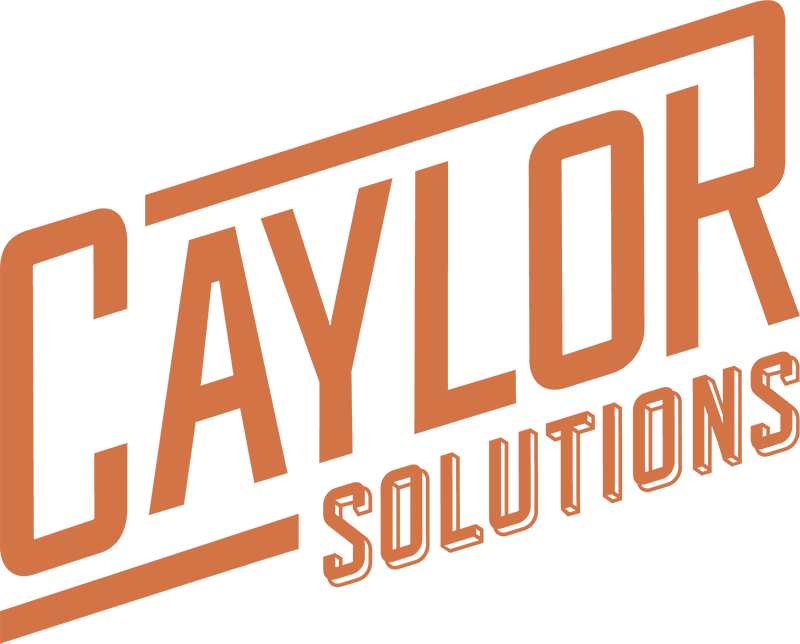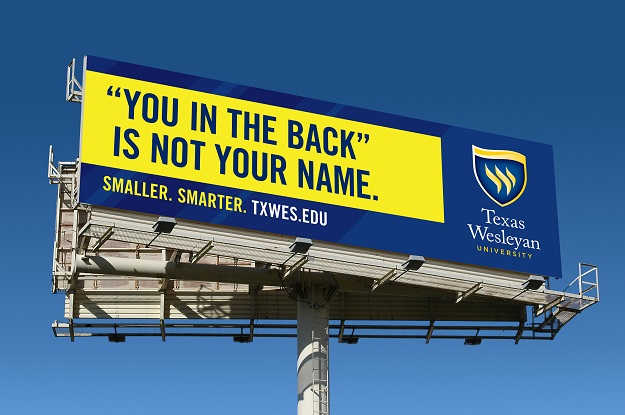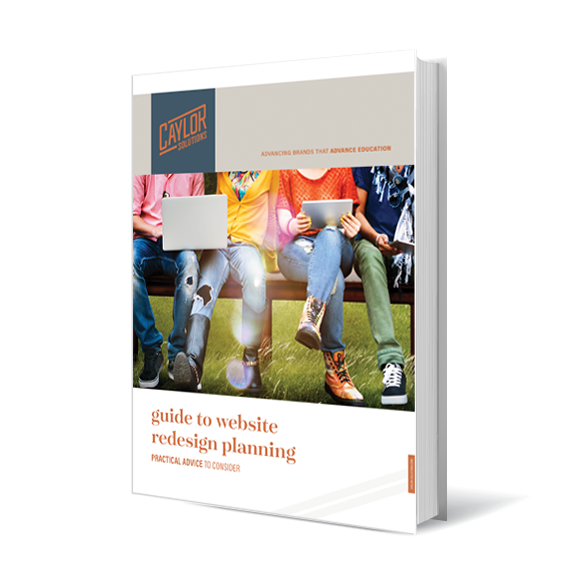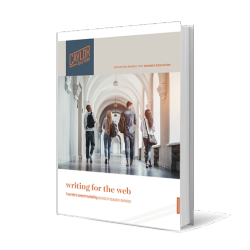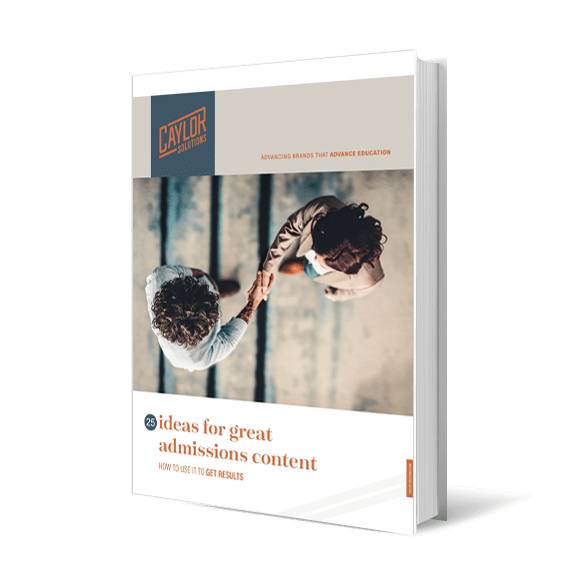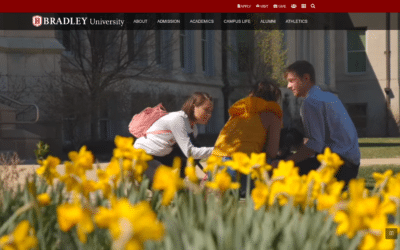Your biggest competitive advantage as a small college or university is you: Your unique selling proposition.
Here’s why so many small colleges are missing their greatest opportunity to hit their admissions goals – and how you can avoid the same mistakes.
When you’re the little guy in your field, marketing and enrollment meetings can often devolve into pity parties.
“If we just had the budget they’ve got…”
“Well, [INSERT BIG SCHOOL NAME HERE] just put in a brand-spanking new sports complex for their athletic program. How do we compete with that?!”
“You know, the staff at [INSERT BIG SCHOOL NAME HERE] don’t have to wear 10 different hats all the time. If we had the personnel they have, we’d be more productive.”
Hey, we’ve all done it. It’s human nature.
But if you give in to the lie that [INSERT BIG SCHOOL NAME HERE] has all the advantages and you’ve got nothing, then you’ll miss out on your biggest competitive advantage.
No matter how you feel, the fact is that you’ve got a lot more going for you than you’d think. You’ve got you!
You may not have the budget, the staff, awards, donors, or connections that a bigger school has…
But you have unique qualities about your programs, campus, and mission that position you perfectly to attract a specially distinct type of student to your school.
This kind of student is looking for a school just like yours. And your marketing has to trumpet all the qualities that you excel in so that this student can find you easily among your competitors.
These unique qualities that only you have among your competitors are what we call your Unique Selling Proposition (USP).
If you took the time to think through everything that makes you unique, then you’ll have all the marketing ammunition you need to blow your competitors away and attract the right students to your institution.
It’s important to think carefully and long about your USP.
Create lists of the unique aspects of your institution that are attractive to the type of student that you want to come to your college or university. Have these USP’s handy when you’re crafting the messaging behind each of your marketing campaigns.
Don’t wing it every time you create a new marketing campaign! Pull out your list of USP’s that you, your team, and your administration have brainstormed and approved.
Track the results you get from each marketing campaign to see if these USP’s are resonating with your target audience. When you land on what makes you unique and valuable to your audience, you should see a marked increase in engagement on your website, social media, and enrollment processes.
Texas Wesleyan University is one school that’s really nailed their USP – and they’re reaping the benefits.
In Texas, TWU is considered a “small” university. They’ve got just over 2,600 students, a student to teacher ratio of 16:1, and a modest endowment of $39.69 million (Compare that to nearby Texas Christian University or Southern Methodist University which both have endowments pegging at the $1.5 billion mark).
But although TWU proves that not everything in Texas is bigger, they’ve certainly shown they’ve got what it takes to compete. Over the last few years, Texas Wesleyan University has invested in a comprehensive marketing campaign wrapped completely around their USP of being a small university.
Billboards around Dallas and Ft. Worth lightheartedly mock the problems that naturally come with a larger campus.
They’ve created funny videos demonstrating their USP.
And their brand, slogan, and campaign names all incorporate their unique selling proposition of being a small university:
Tagline
Smaller. Smarter.
The “Elevator Speech“
We’ve been doing great things at Texas Wesleyan for more than 120 years – and we’re just getting started.
We think smaller at Texas Wesleyan. Smaller means we’re teaching students to think for themselves in small classes. Smaller means we’re sized to prepare students for graduate school, or a professional career. Smaller means our faculty really does transform the lives of students.
And smaller means the bill, too. Texas Wesleyan does all this at a lower price than other top-tier, private universities. We might be smaller, but isn’t that smarter? – Pulled from TWU’s website
There is one thing I’d like to point out about TWU’s ad campaign…
Being small isn’t necessarily a USP.
There are lots of colleges and universities just as small or smaller than TWU—which means it’s not really “unique.” So what is it that makes this claim so powerful in their marketing message?
They own it. They’ve decided that this is their most marketable advantage to their prospective student, and they’ve consistently applied it to every message they send out.
Below, I’m going to give you a list of possible USP’s that apply to most small colleges and universities—but use them with caution.
These USP’s could possibly work for many small colleges, making them much less unique than a true USP should be. The reason I give them to you is because they are great starting points to get you thinking in a positive direction about your institution.
While these should not be considered your USP’s, they will help you start to understand more clearly what yours might be. An example of a possible USP might be that of Montana Bible College, a small college which focuses everything through the lens of discipleship, and everything they do is informed by that perspective. Another is Crossroads Bible College – they focus everything through their lens of urban ministry. Those are unique.
Here’s a quick starter list of common advantages small colleges and universities have over their mammoth competitors.
- Small classes. When attendance numbers are low, educational quality is high. And the way a student feels in a smaller academic setting is HUGE. Never underestimate the desire in young students to receive individual attention and care.
- Greater student involvement. Smaller staff sizes means that professors have to use student volunteers more often. This provides students real-life experience in their fields of learning while strengthening the bond they have with their professors.
- Higher quality professors. The chances of getting a rookie graduate student as an instructor are much higher in a large university that has numerous graduate programs with grad students that need trained to be professors.
- Focused on students not research. Generally speaking, professors at big research schools have to prioritize their research over their teaching roles in order to preserve their careers and climb the ladder. This isn’t the case for most small colleges and universities, where the way to advancement for professors is in teaching performance.
- More feedback. With a smaller class size, professors have time to provide comprehensive, thoughtful feedback on students’ work. Big schools breeze through papers as quickly as possible because of the sheer volume of papers (if not done electronically) that need to be graded.
- More papers written. Students that come from a smaller school typically have written more papers before graduation than their larger school counterparts. And the more a student writes, the better they’ll be at communications – which is a must have skill in today’s global, connected economy.
- Flexible curriculum. Naturally more nimble than large schools, small colleges and universities are able to create and implement new, innovative curriculum for the changing needs of today’s students. And because they don’t have all the broad-stroke policies of a large school, they don’t always have to force programs and classes on every student.
- More collaboration. Smaller class sizes give students more of an opportunity to collaborate with professors in groundbreaking research and cutting edge thought leadership.
- Less bureaucracy. In large institutions, there are armies of secretaries and endless litanies of departments all of which make it hard to get your questions answered.
- Personal touch. In smaller colleges and universities, it’s quite possible that everyone will know your name. There’s really not much you can do to replace the feeling of being special that every student (person, really) craves.
So wherever you land when it comes to class size or budget, remember your biggest competitive advantage is you. Nail down your USP, and make sure it’s prominent in every marketing message you create.
If you are looking to craft a powerful marketing message that will cut through the clutter of your competitors and attract the students you’re looking for, then contact us today for a free website evaluation.
Market More. Spend Less.
Set yourself free from your shrinking marketing budget with my popular ebook Marketing on a Shoestring Budget! This ebook is jammed with practical ways to produce high-quality marketing on the cheap.
Inside, I’ll show you proven marketing tactics like…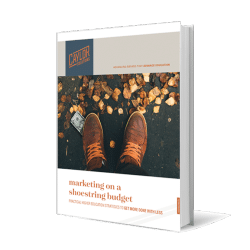
-
- How to leverage low-cost technologies to reach your target market,
- How to craft a content marketing strategy on a bare-bones budget,
- The number one thing your website needs to do,
- The key to getting free, organic traffic to your website, and more.
No hype. No pie in the sky. Just real solutions for getting the job done with the budget you’ve got.
Featured image by Mark Carrel via Adobe Stock
